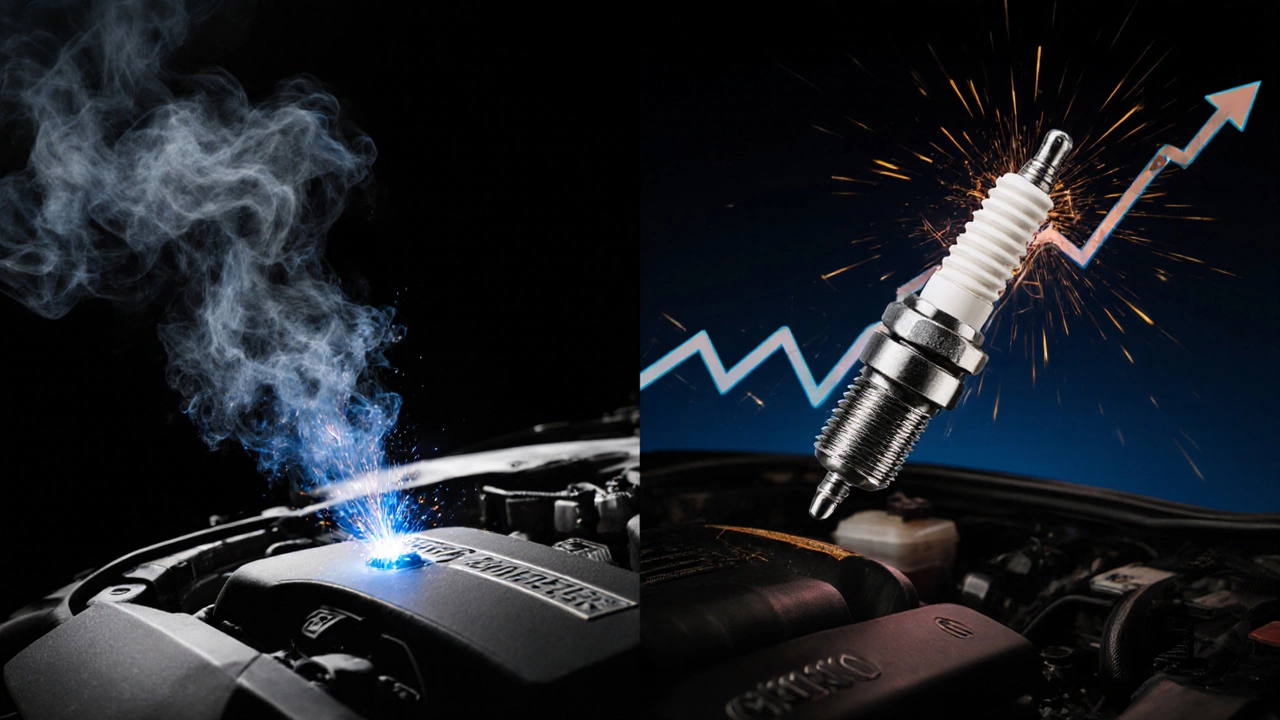Spark Plug Fuel Savings Calculator
Fuel Efficiency Calculator
Estimate how much you could save on fuel after replacing worn spark plugs. Based on SAE studies showing 4-8% fuel efficiency improvements.
Estimated Results
Based on SAE study showing 6.3% average fuel efficiency improvement after replacement. Actual results may vary based on vehicle condition and driving habits.
Ever noticed your car sputtering on cold mornings, or maybe your fuel bill suddenly jumped? You might be wondering if a spark plug change is the fix. The short answer? Yes - if your plugs are worn out. But it’s not magic. It’s physics.
What Spark Plugs Actually Do
Spark plugs are the ignition source in your engine. They sit in the cylinder head and send a high-voltage spark across a tiny gap to ignite the air-fuel mixture. That explosion pushes the piston down, and that’s how your car moves. Simple. But when those plugs get old, dirty, or worn, the spark weakens. It might misfire. It might be late. Or it might not happen at all.
Modern cars usually have spark plugs that last 60,000 to 100,000 miles, depending on the type. Copper plugs wear out faster - around 30,000 miles. Platinum and iridium last longer. But even the best plugs degrade over time. Carbon buildup, electrode erosion, and oil contamination all chip away at their ability to spark cleanly.
How You’ll Notice a Difference After a Change
After swapping in new spark plugs, you’ll likely see changes - if the old ones were bad. Here’s what real drivers report:
- Smother idle: No more shaking or roughness when stopped at lights.
- Better acceleration: The car responds quicker when you press the gas. No hesitation.
- Improved fuel economy: Most people see a 4% to 8% boost in MPG. That’s about 1 to 2 miles per gallon on a typical car. Over 10,000 miles, that’s 50 to 100 extra miles of driving - worth the cost of a set of plugs.
- Easier cold starts: No more crank-and-wait on chilly mornings.
- Quieter engine: Fewer misfires mean less knocking or pinging.
These aren’t guesses. A 2023 study by the Society of Automotive Engineers tracked 1,200 vehicles with over 75,000 miles. Cars with neglected spark plugs saw an average 6.3% drop in fuel efficiency compared to those with fresh plugs. After replacement, 89% returned to factory-rated efficiency.
When a Spark Plug Change Won’t Help
Changing spark plugs won’t fix everything. If your car still runs poorly after new plugs, the problem’s elsewhere. Common culprits:
- Faulty ignition coils: One bad coil can cause misfires even with perfect plugs.
- Dirty fuel injectors: Clogged injectors starve the engine of fuel.
- Bad air filter: Restricts airflow, messes up the air-fuel ratio.
- Vacuum leaks: Let unregulated air into the engine, throwing off combustion.
- Low fuel pressure: The fuel pump might be failing.
If you’ve got a check engine light, get a code reader. Codes like P0300 (random misfire) or P0301-P0308 (cylinder-specific misfires) often point to spark issues - but sometimes they’re caused by coils or fuel delivery. Don’t assume plugs are the only fix.

What Type of Spark Plug Should You Use?
Not all spark plugs are equal. Your car’s manual says what’s recommended. Don’t just grab the cheapest set. Here’s the breakdown:
| Type | Lifespan | Best For | Cost Range |
|---|---|---|---|
| Copper | 20,000-30,000 miles | Older cars, budget builds | £5-£10 per plug |
| Platinum | 60,000-80,000 miles | Most modern engines | £10-£20 per plug |
| Iridium | 80,000-120,000 miles | High-performance, turbocharged engines | £15-£30 per plug |
Iridium plugs are the gold standard for most 2010+ cars. They’re more expensive, but they last longer and give a sharper spark. Copper plugs? Fine for older models, but they’ll need replacing every couple of years. Don’t go beyond the manufacturer’s recommendation - wrong heat range or gap can damage your engine.
How Often Should You Replace Them?
Follow your owner’s manual. But here’s a practical rule: if your car’s over 60,000 miles and you’ve never changed the plugs, it’s time. Even if it’s running fine. Degradation is slow. You won’t feel it until it’s too late.
Some signs you’re overdue:
- Engine light on with misfire codes
- Sluggish acceleration
- Increased fuel consumption
- Hard starting in cold weather
- Rough idle that smooths out after warming up
Don’t wait for failure. Spark plug failure can cause catalytic converter damage - and that repair costs 10x more than a plug change.

Can You Do It Yourself?
Yes. Most people can change spark plugs in under an hour with basic tools: a socket wrench, extension, spark plug socket (with rubber insert), and torque wrench. Gap the new plugs before installing - they’re not always preset right.
Pro tip: Change them when the engine is cold. Hot engines can warp the threads. Remove one plug at a time. Don’t remove them all at once - you risk debris falling into the cylinders. Clean the area around each plug hole with compressed air before pulling the old one out.
Use a torque wrench. Over-tightening cracks the ceramic insulator. Under-tightening causes leaks. Most plugs need 15-20 lb-ft of torque. Check your manual.
What Happens If You Skip It?
Ignoring worn spark plugs doesn’t just hurt performance. It can wreck your engine. Misfires send unburned fuel into the exhaust. That fuel ignites in the catalytic converter, overheating it. A melted converter costs £800 to £1,500 to replace.
Also, incomplete combustion leaves carbon deposits on valves and pistons. Over time, that builds up, reduces compression, and lowers power. You’re not just wasting fuel - you’re slowly killing your engine’s efficiency.
Bottom Line
Changing spark plugs won’t turn your old car into a sports sedan. But if your plugs are worn, it’s the single most cost-effective upgrade you can make. You’ll get smoother driving, better mileage, fewer breakdowns, and avoid expensive repairs. It’s not about performance gains - it’s about restoring what your car was designed to do.
If your car’s running rough, your fuel economy’s dropped, or you’re past 60,000 miles - replace the plugs. It’s cheap. It’s easy. And it works.
Do new spark plugs improve gas mileage?
Yes - if the old ones were worn. Most drivers see a 4% to 8% improvement in fuel economy after replacing old or fouled spark plugs. That’s about 1 to 2 extra miles per gallon. For a car that gets 30 MPG, that’s 150-300 extra miles per tank over 10,000 miles.
Can bad spark plugs cause the check engine light to come on?
Absolutely. Faulty spark plugs cause misfires, which trigger codes like P0300 (random misfire) or P0301-P0308 (cylinder-specific misfires). The check engine light will usually come on within a few driving cycles. A code reader can confirm it’s spark-related - but always check coils and fuel delivery too.
How long do spark plugs last?
It depends on the type. Copper plugs last 20,000-30,000 miles. Platinum plugs last 60,000-80,000 miles. Iridium plugs can go 80,000-120,000 miles. Always follow your car’s manual - some modern engines require replacement at 100,000 miles regardless of condition.
Is it okay to mix spark plug brands?
Yes - as long as the type, heat range, and gap match your car’s specs. A NGK iridium plug works just as well as a Denso or Bosch if they’re the same model number. Don’t mix different types (e.g., copper and iridium) in the same engine. Stick to the manufacturer’s recommended part number.
Can spark plugs cause rough idle?
Yes. Worn or fouled spark plugs often cause rough idling because they misfire at low RPMs. The engine runs unevenly, shaking the whole car. This usually gets worse when the engine is cold. Replacing the plugs typically fixes it - unless there’s a deeper issue like a vacuum leak or bad coil.
If you’re unsure whether your plugs need replacing, check your service history or pull one out with a socket. Look for black soot, white deposits, or eroded electrodes. If it looks bad, replace all of them. It’s not worth the risk.






